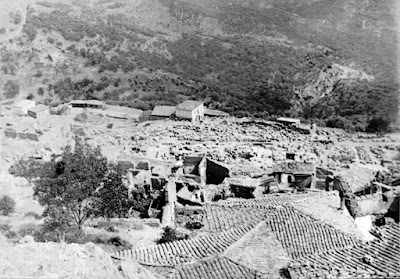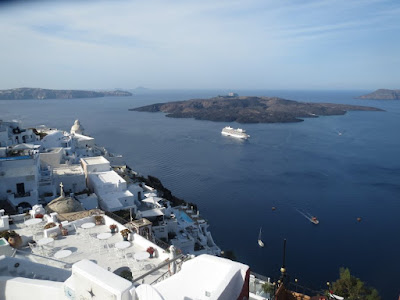The lecture is the first of 2015/2016 Lecture Program of the Syllogos Filon tou Istorikou Archeiou tis Archailogikis Yperesias. The lecture will be held at the Historical Archive Building at Psaromylingou 22 on the cusp between the Kerameikos and the Psyri Districts. The Theseio train station is the closest stop in the Metro system. The public is welcome!
The “other” Santorini
Almost anyone living in Greece, and especially Athens, for the past five years could not have failed to see the devastating effects of the economic crisis brought on to a large part by the high level of public debt, ineffective tax collection, and mediocre political leadership. The economic medicine forced on the country by the then “troika” and now the “institutions” often seems to exacerbate the situation rather than lead the country to renewed growth and prosperity. Greater tourism is often heralded here as the economic driving force that will create the much needed jobs, encourage sought after development and generate the increased tax revenue for the country. The rich and diverse cultural heritages of the country along with the inherent beauty of Greece’s varied natural landscapes and seascapes are frequently argued as what draws tourists to the country. But is “industrial scale tourism” really a long term answer to creating a vibrant, sustainable national economy that safeguards the cultural heritage and the environmental capital of Greece? Are there better alternatives?
Recently my wife and I joined a specialized tour to the island of Santorini where we saw the effects of year-round “industrial-scale tourism” (as the permanent residents call it) on the island’s fragile, unique environment. Even in mid-October Fira and Oia with their repetitious commercialism are overwhelmed with both individuals and large groups while the other regions of the island and their attractions have a different experience. What could be a more sustainable, more culturally focused and more widely distributed forms of tourism? The four interrelated themes of the tour were Greek cuisine utilizing exclusively local and regional agricultural products, Santorini wines and wineries, the production and the processing of traditional local agricultural products, and the rich cultural heritage of the island – archaeological and traditional.What we saw were a series of widely-distributed local nodes – focusing on the cultivation and processing of local agricultural products (fava, Santorini tomatoes, white melitzanes, pistachios, indigenous Assyrtiko, Athiri and Aidani grapes, wild capers, candied fruits, Chloro cheese), wineries and wine tasting (Boutari, Santos, Sigalas, Canava Roussos), the industrial heritage of the island (D. Nomikos cannery), creative cuisine and cooking lessons (Selene, 1800, Vassilios, Krinai, Psaraki), archaeological sites, museums and churches (Akrotiri, ancient Thera, Archaeological Museum, Museum of Prehistoric Thera), folk heritage (Santorini of the Past) and traditional settlements (Pyrgos, Finikia, Megalochori) – that formed a flexible network that lies mostly beyond the sprawl of the two tourist towns on the edge of the caldera.These nodes have been created by individuals, cooperatives and companies with visions for both celebrating the island’s traditional strengths and in preserving them in a sustainable fashion. Other companies have developed to provide tours and transport to these disbursed locations. You can also connect the nodes on your own by following the extensive network of marked trekking trails or by renting a bicycle. In the process they have created jobs (especially for the younger and the older components of the work force and for those who want to remain on the island), they are preserving the fast-disappearing agricultural land, they have made worthy, often unique value-added products for local consumption and for export, and they have provided a holistic context for understanding and appreciating Greek culture – past and contemporary – for the visitors to this country. If this imaginative trend of creating local nodes of interest (beyond the limit of the well-known “sun and sea” mentality) were duplicated on the other islands of the Cyclades then a broader network of small networks would be created. These in turn could be linked to similar local and regional networks in the other diverse geographical regions of Greece. In this way the tourists to the country could be enticed away from just visiting the often overcrowded usual “top 10” attractions. Such a small country, but it has such diversity. The potential for a sustainable economy with these small networks is palpable.With these many interesting possibilities in mind one can now imagine picturesque Santorini as more than a view of the caldera amongst the tourist shops or watching the sunset at Oia with thousands of day trippers from the cruise ships. The rest of Greece can be like this too with imagination, cooperation, effort and support from the state!
Cordially,
David Rupp
Director









No comments:
Post a Comment